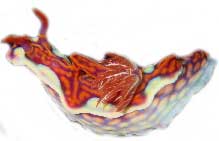 Accommodation | International
Flights | Domestic
Flights | Tours
| Travel
Insurance | Car
Hire | Visas
| Shopping
| Dating
| Humour
Accommodation | International
Flights | Domestic
Flights | Tours
| Travel
Insurance | Car
Hire | Visas
| Shopping
| Dating
| HumourNudibranches

Nudibranches are best described as marine underwater snails,
but instead of being protected by a hard shell like normal snails
they rely on bright colors to scare off potential attackers
( bright colors often indicate toxicity in nature). The colors
are also used as a disguise to blend the animal into the background.
Over 3000 species are known to science and they come in a huge
variety of spectacular bright colors.
The name nudibranch actually means naked gills, you can see
the gills on the back of the animal as the bits that flutter
around. They also have two feelerhorns (rhinophores) and one
row of teeth known (radula), their appearance varies of what
they feed on.

You may be lucky enough to encounter this graceful animal while
snorkelling or diving the Great Barrier Reef, while they enjoy
living on the ocean floor at depths up to 700 metres they are
also found near the surface. Do not be tempted to touch them,
they are extremely fragile and easily damaged!
They usually graze on sponges, barnacles, anemones etc. but
some feed on corals and store the photosynthetic algae known
as zooxanthallea in their bodies where they continue to photosynthesize,
thus producing an ongoing supply of energy for the nudibranch.
They are hermaphrodites and have both male and female sex organs,
making it much easier to find a mate. After mating eggs in a
huge variety of colors, shapes and sizes are laid around where
they feed and they take from 5 to 50 days to develop, depending
on water temperatures.
This page
was written for us by Rob Lapaer who runs Rainforest
Hideaway B&B in Cape Tribulation, North Queensland. |
If you would like to add something to his page contact
HOME PAGE
Tourist Information
General Information
And Entertainment
ACCOMMODATION IN AUSTRALIA
Bed
& Breakfast
Budget
Accommodation
Backpackers Hostels
Hotels
in Australia
CAR HIRE IN AUSTRALIA
Australia Rental Cars
And
Campervans

TOURS
IN AUSTRALIA
What To Do In Australia
On-line
Shopping
On-line
Dating
![]()
About
Australia
Visas For Australia
How
To Get To Australia
How To Get Around
Travel Insurance
Travel Guides
Working
In Australia
Australian
Posters
Survival
Tips
Weather,
When To Go

Use of
this website constitutes acceptance of the User Agreement for this website
Contact us |
Advertise on this site
| Link to this site |Add
your photos or stories to this site |
Webmasters | Affiliates
